In early April 1982, Argentina invaded the Falkland Islands, a few desolate rocks in the South Atlantic. The British mobilized their fleet in response. The carriers arrived off the Falklands on May 1st, swiftly defeating the Argentine Air Force. The Argentine Navy tried to interfere the next day, but withdrew after the cruiser General Belgrano was sunk by a submarine. Two days later, the Argentinians struck back, sinking the frigate Sheffield with an Exocet missile. Two weeks later, on May 21st, British troops landed at San Carlos Water on the west coast of East Falkland. The Argentine Air Force quickly got wind of this, and launched numerous sorties against the invasion fleet. The brutal battle ran for five days before the Argentinian attacks petered out. Unfortunately, the 25th saw the destroyer Coventry and the cargo ship Atlantic Conveyor sunk by air attack. A few days later, the British began their breakout, defeating the Argentinians at Goose Green in the first land battle of the war.1
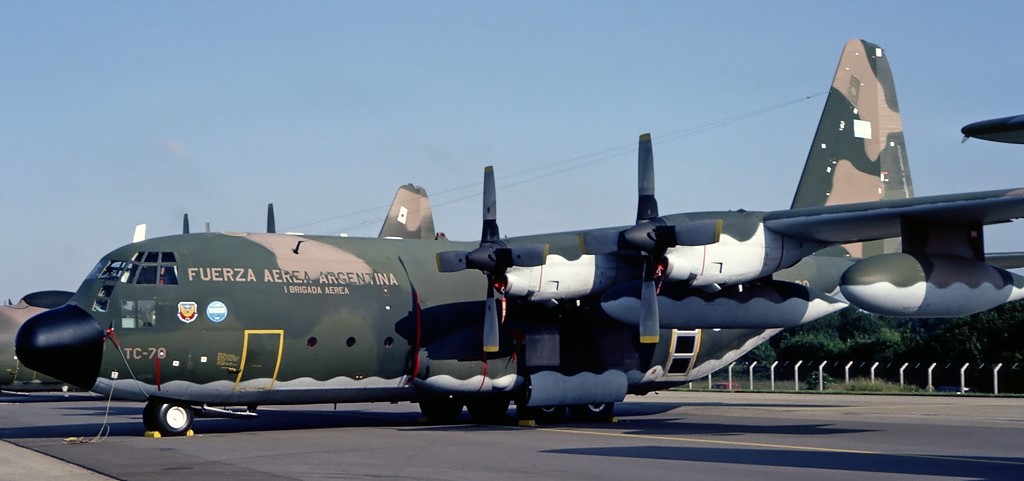
An Argentinian Hercules
While the 29th was most notable for the capture of Goose Green, it was a busy day elsewhere. The final bomb on Sir Lancelot was disarmed, clearing the ships in San Carlos of unexploded bombs for the first time in 8 days. The Argentinians also paid their first visit to San Carlos since the 25th, when two aircraft made a recon pass, with one of them, a Dagger, falling to a missile. At almost the same time, the tanker British Wye was coming under attack 780 miles to the northeast from a rather unlikely airplane. The British had been well aware of the air threat to their long and perilous logistics chain, and had made sure to remain out of range of Argentina's Canberra bombers. The Argentinians had countered this by fitting Pucara bomb racks to some of their C-130s, one of which found the tanker and dropped eight bombs on her. Fortunately for the British, the only hit bounced off the forecastle, but the merchant ships were quickly rerouted to keep them out of C-130 range as well.
Among the ships of the Task Force, the 29th was a day of shuffling. Ships moved between South Georgia, the logistical waiting area, the carrier group and San Carlos. The carriers flew a heavy load of strike missions, hitting Stanley with 20 bombs and the Pebble Island strip with 12, and providing support to the SAS on Mount Kent. One Sea Harrier was lost to a freak accident when a gust of wind sent it sliding across the deck. One of the outriggers went over the edge of the deck, and it toppled over into the sea, the pilot punching out safely and being picked up by a helicopter. The evening saw the usual coastal bombardments, with Arrow going after Fox Bay and Glamorgan and Ambuscade hitting Stanley again to deter the regular C-130 transport flight. The Argentinian artillerymen were getting their eyes in against moving targets, although neither of the ships were hit.
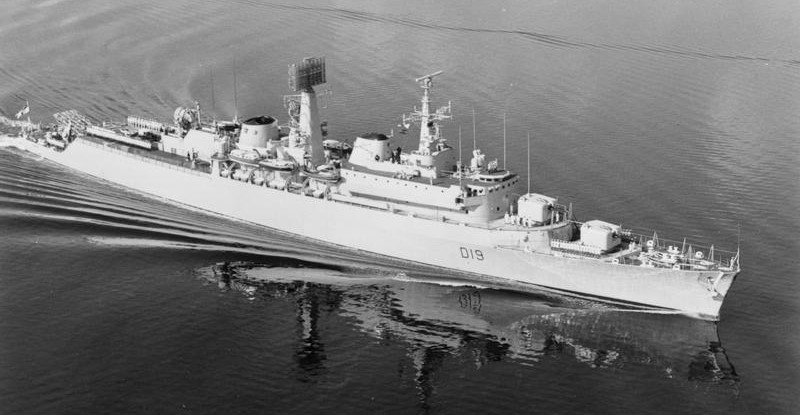
Glamorgan
The 30th saw several raids by the GR3s from Hermes. One section attempted to use laser-guided bombs which had recently arrived, but discovered that the laser rangefinders they had were not suitable for target designation. Another attacked troop concentrations, but one of its members was hit by AA fire and began leaking fuel. The pilot ran out of fuel and was forced to eject 30 miles from Hermes.
The biggest excitement of the day was an attempted airstrike on the carriers. It was composed of two Super Etendards, one carrying Argentina's last air-launched Exocet, accompanied by four Skyhawks that would go in with bombs after the missile hit one of the carriers.2 This was the only combined operation of its type during the war, and it was planned very well, with the six aircraft making use of a KC-130 tanker to dodge around the Falklands and come in from the southeast, well away from the main axis of British defenses.

An Argentinian Super Etendard
When they estimated they were within range, the Super Etendards popped up and swept the area in front of them with their radars. Their navigation was surprisingly accurate, with the frigate Avenger 30 miles dead ahead, and Invincible about 45 miles out, 30° to starboard. Unfortunately, heavy showers scattered throughout the area looked a lot like ships, so they descended again to close the range. Worse, the burst of radar alerted the ESM crews on the British ships, and the Type 42s Cardiff and Exeter raced to join Avenger on the new threat axis. Three minutes later, the Argentinian jets reappeared, and Exeter, 32 miles away, quickly locked on with her Sea Darts. This time, the lead Argentine pilot got a firm lock, and fired his missile at a target 21 miles away, halfway between Avenger and Exeter and nowhere near Invincible. The Super Etendards then broke off, pursued fruitlessly by a pair of Harriers, while the Exocet was never seen again, probably chasing a chaff cloud into the sea.3
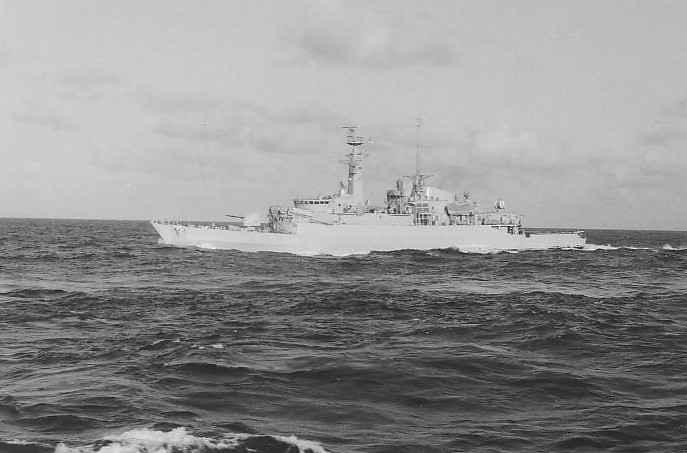
HMS Avenger on the way to the Falklands
The Skyhawks bored in, planning to bomb the stricken carrier they were sure was waiting for them. A ship appeared eight miles ahead, and to the pilots, flying at low level through the spray, it looked like Invincible, with smoke pouring from her. It was in fact Avenger, but the Skyhawk pilots soon had their distraction added to when an unseen Sea Dart from Exeter felled one of their number. Another was shot down by gunfire from the frigate, and the two survivors raced overhead, their bombs falling around the British ship. Upon their return home, they spun a lurid tale of their attack on Invincible, which soon gained credence in Argentina among both the military and the public. Many were surprised when the carrier returned to Portsmouth undamaged, and a few continue to insist to this day that she was actually sunk and somehow the British magically created a replacement carrier.4 The Exocet threat was now gone. Argentina combed the world's arms markets for more missiles, but none were to be had at any price, thanks to French and British efforts.5
The British quickly got back to work, preparing for the night's activities. In case the Super Etendards were refueling at Stanley, Sea Harriers lofted bombs at the airfield. Ships shuffled between San Carlos, the carrier group, and the logistics force further out from the islands. Cardiff closed in on Port Stanley, hoping to shoot down any planes making use of the airfield during the night, while Alacrity moved inshore to provide gunfire support to the SAS on Mount Kent, who were finally reinforced by a company from 42 Commando, giving the British a position from which land-based guns could shell Stanley. Avenger spent the evening shelling Argentinian observation posts to cover the insertion of yet another SBS recon team before entering Falkland Sound for the first time.
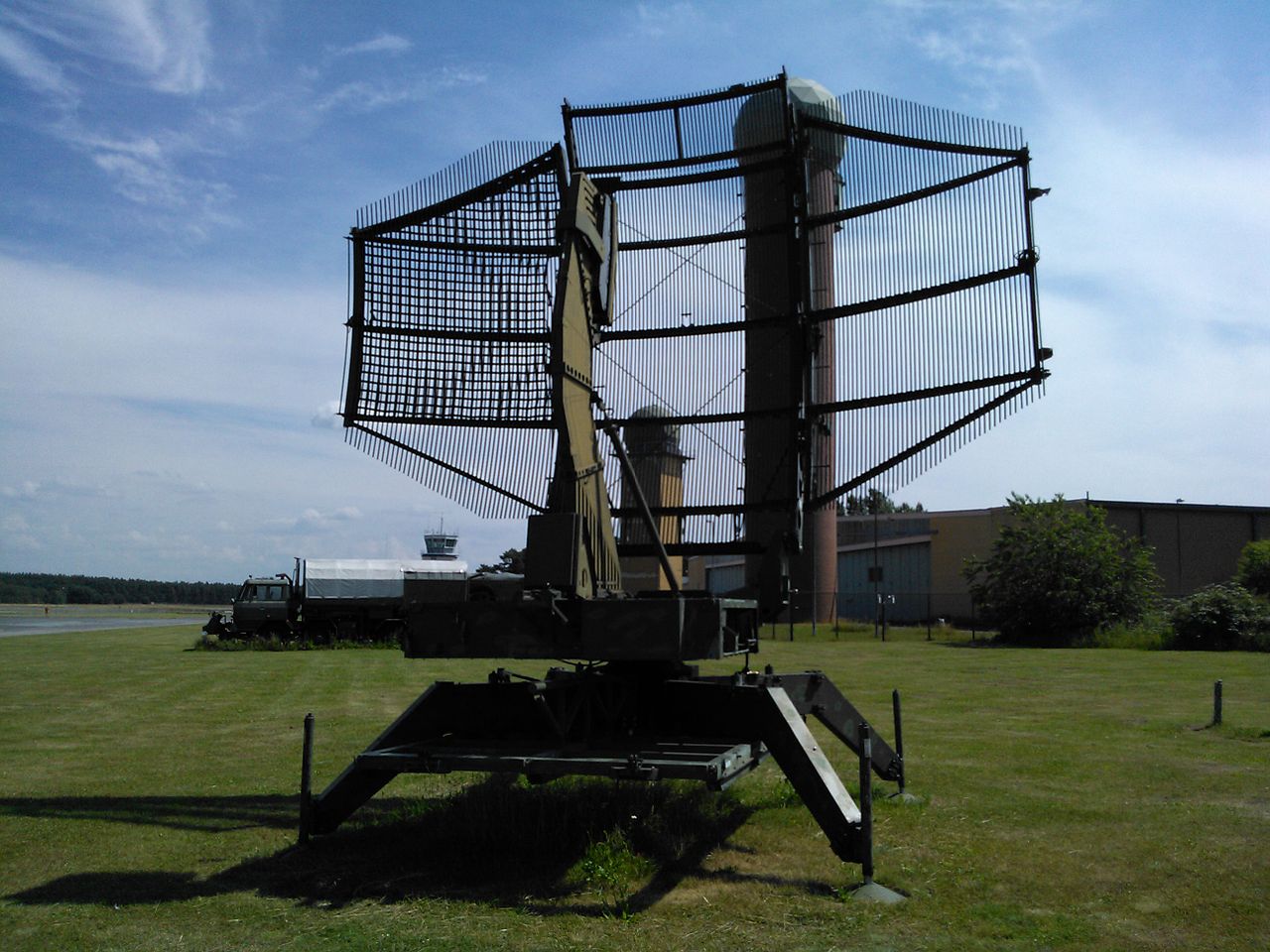
AN/TPS-43
The British realized that the AN/TPS-43 surveillance radar operated by VYCA-2 was one of the major obstacles to gaining air superiority over the Falklands. The operators had used it to locate the carrier group with uncomfortable precision on several occasions, and they had become experts at keeping strike aircraft out of the reach of the Sea Harrier CAP. Unfortunately, it was located on the edge of the city of Stanley, and the risk to civilians from an unguided bomb or artillery shell was too great. A precision weapon was needed, and until a laser designator arrived in the South Atlantic, the forces there had none. The solution the British came up with was to fly another Black Buck mission, replacing the bombs with a quartet of Shrike anti-radiation missiles. The first attempt was made on May 28th, but one of the supporting tankers had a hose problem and the mission aborted. The second attempt was more successful, with the Vulcan arriving in the early hours of the 31st.
To make sure that the TPS-43 radar was on, an obvious necessity for anti-radiation missiles, a pair of Sea Harriers were launched to attack the airfield at Stanley. The Argentinian operators had been warned of the possibility of an ARM attack, and shut down most of their radars. The TPS-43 was put on low power, in hope of luring the Vulcan in, but the crew was aware of its location, and the two sides spent half an hour shadowboxing before the Vulcan fired a pair of Shrikes. One of them impacted within 10-15 yards of the radar, doing minor damage to the antenna, although it was operational again with 24 hours. The other missed by a greater margin, and the Vulcan turned for home.
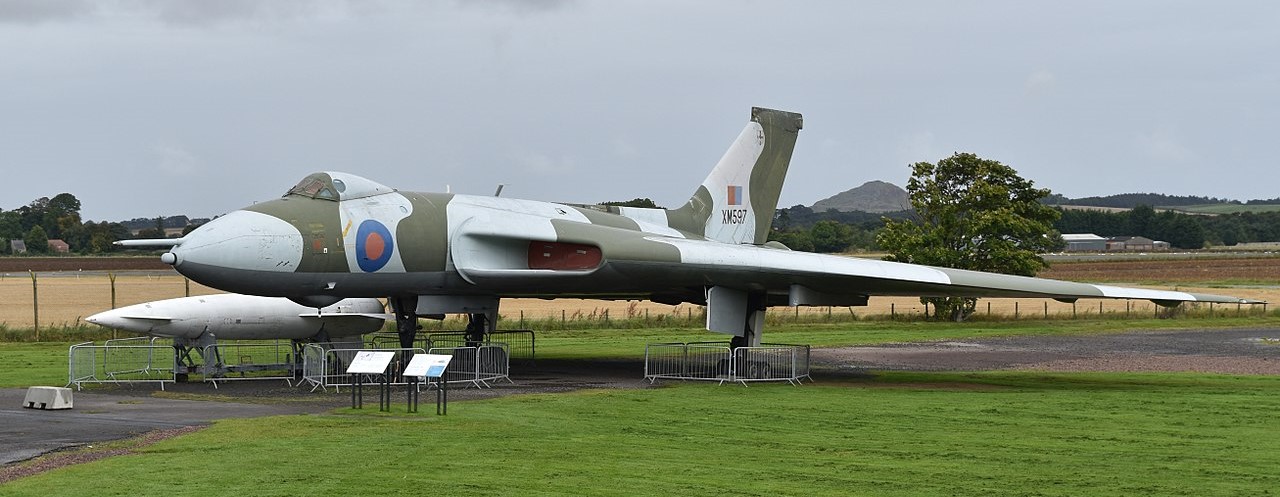
Vulcan XM597, the strike aircraft on the 31st
The rest of the 31st was relatively quiet. The carriers launched three strikes on Stanley with their Sea Harriers and GR3s, while RFA Fort Grange, on her way south to join the task force, was buzzed by an Argentinian Hercules, which broke off without attacking, probably under the belief that she was a proper warship. The hospital ship Uganda entered Falkland Sound to pick up casualties from Ajax Bay, and was later joined in the "Red Cross Box" by the Argentine Bahia Paraiso, earlier used as the assault transport at South Georgia. The British exercised their right to search her, and found no contraband aboard.6 On land, a great deal of work was done to establish the forward headquarters at Teal Inlet, with LCUs beginning to ferry supplies forward from San Carlos. A dusk air-raid on the beachhead turned back without entering San Carlos or interrupting the arrival of another convoy of ships coming in to unload supplies and the first elements of 5 Infantry Brigade. Ashore, a patrol of Royal Marines wiped out an Argentine observation post near Teal Inlet.
The end of May saw the British in a commanding position. They had weathered the worst Argentina could throw at them for a full month, won a battle of attrition with the land-based air forces, landed a full brigade and now stood at the gates of Stanley. But while the major momentum had shifted ashore, there was plenty of excitement coming for all parties involved in the first days of June, which is where we'll pick up our story next time.
1 For more information on ships and aircraft, as well as links to the whole series, see my Falklands Glossary. ⇑
2 Argentina's Exocet operations were marked by a complete disdain for making sure that the missiles were actually targeted on a carrier, instead of an escort. I'm not sure why this was, particularly after the first two missile strikes hit things that were notably not carriers. It's possible that Argentinian High Command wasn't listening to the BBC. ⇑
3 Initially, Avenger claimed that she had downed this missile with a shell from her 4.5" gun, but more recent information indicates it was either decoyed off or shot down by a Sea Dart from Exeter. ⇑
4 I promise I am not making this up, despite the patent absurdity of the British successfully covering something like this up. They would have to convince the families of the dead to not come forward, and build a new carrier in a matter of weeks that would serve for another 30 years. Or as someone online put it, "if we were able to repair an Exocet hit and the bomb damage in four months without the world noticing, we deserved to win." ⇑
5 The Super Etendards began practicing for conventional bombing attacks, but their crews hadn't become proficient by the time the war ended, and they played no further part in the conflict. ⇑
6 Observance of the Laws of War by both sides was excellent throughout the conflict. ⇑

Comments
Do you think letting their air force be gradually attrited through small, uncoordinated strikes was intentional on the A's part? Or were they just unable to organize larger attacks?
Most people and (RAND corp guys) writing about strikes on carrier forces envision the attacker throwing everything they have at the carrier to overwhelm its CAP and AA. This weeks-long trickle of sorties seems like the exact opposite of that.
There were a couple of issues, but the biggest one was limited aerial refueling capacity. They couldn't put more than a handful of Skyhawks over the Falklands at once because of that. They had more options with the Daggers, but the basic problem there was probably that doing coordinated alpha strikes is hard. You need to make sure that each base is capable of producing the required sorties at the correct time to have everyone arrive at once, or reasonably close. The Argentinians weren't really up to doing that, so each base/unit went independently.
The Argentinian operators had been warned of the possibility of an ARM attack...
Warned how? By whom? Was this just another case of the BBC announcing ahead of time what the secret British plan was?
...and shut down most of their radars.
So I'm guessing that an ARM is really not suitable for an attack by itself. It's really best when combined with a conventional attack so the defenders are faced with the choice of lose their radar or lose their airfield.
That's a good question, and one I don't really have the answer to. It's quite possible it was just guesswork on the part of Argentinian intelligence.
ARMs are powerful, but also hard to use effectively. I'm working on a post about this right now.
Would it have been at all possible to use the vulcan to airdrop in the replacement Ferranti laser designators?
Stick it in an empty cluster bomb case with a chute or something?
Call it 0th class post.
The Vulcan, no. But they did have a semi-regular supply via air-refuled Hercules. I'm pretty sure that's how the LGBs got to the South Atlantic, and it was probably just a matter of it taking too long for them to get a designator, get it to Ascension and packed for drop, fly it out to the Task Force, drop it, fish it out of the South Atlantic, then either get it ashore with a special forces team or integrate it onto a Harrier for the first time. There was a surprising amount of stuff that took that route, although I've only mentioned it briefly (I believe in the Black Buck post, which was over a year ago, and I definitely don't blame you for not remembering.)
"discovered that the laser rangefinders they had were not suitable for target designation" That's embarrassing...